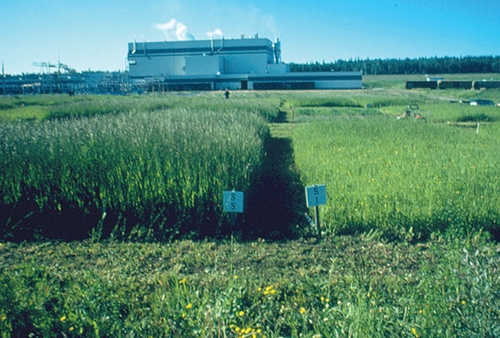
Features
Fertilizer
Seed & Chemical
From waste to fertilizer
Agricultural producers in and around Whitecourt and Slave Lake, Alta., have been profiting greatly from what was once thought of as a “waste product,” mechanical pulp sludge, produced by Alberta Newsprint Company (ANC), Millar Western Forest Products and Slave Lake Pulp (SLP). This is all thanks to 20 years’ worth of research led by the Alberta Research Council (ARC) (now part of Alberta Innovates - Technology Futures) with support from the Mechanical Pulp and Paper Consortium Research Program.
June 5, 2013 By D. Degenhardt B. Drozdowski and R. Faught
 Figure 1. growth in 50 bdt/ha sludge treatment (left) compared to 10 bdt/ha sludge treatment (right) in 1993 Agricultural producers in and around Whitecourt and Slave Lake. Alberta
Figure 1. growth in 50 bdt/ha sludge treatment (left) compared to 10 bdt/ha sludge treatment (right) in 1993 Agricultural producers in and around Whitecourt and Slave Lake. AlbertaMechanical pulp sludge, a byproduct of the pulping process, is an excellent source of organic matter, composed of short lignin fibres, high in carbon (45 percent) and containing plant nutrients such as nitrogen and phosphorus (total N ranges from 1.5 to 3.0 percent and total P ranges from 0.3 to 0.5 percent). It has a neutral pH and an electrical conductivity (EC) of approximately 2.2. Over the years, many research plots have been established to evaluate the impact of single and multiple applications of sludge from different mills to obtain long-term data relative to the impact on crop yields and soil quality. The benefits of sludge application on agricultural land have been overwhelmingly positive; sludge not only acts as a slow-release fertilizer but also provides many benefits as a soil amendment. In a long-term study established in 1992, it was found that 50 bone dry tonnes (BTD)/ha would increase bromegrass productivity fivefold compared to control plots. The increase in yield from mechanical sludge application was sustained for six growing seasons (Figure 1). Further, the soil analysis showed that the total N in the 30 and 50 BDT/ha treatments remained elevated for at least three years post-application.
In another project at the ANC Mayerthorpe site, it was demonstrated that a one-time sludge application of 50 BDT/ha would yield the same quality and quantity of barley as application of 200 kg/ha of 35-15-0 fertilizer annually over three years. Residual benefits from the sludge were seen even after five years from the initial sludge application. Sludge can supply a total of 15 to 30 kg N/tonne and most of the nitrogen in sludge exists in the organic form, and becomes available on a “slow-release” basis. The average cost savings associated with annual fertilizer application is significant for agricultural producers who have access to pulp sludge. Other beneficial aspects of sludge include the ability to improve soil structure and tilth, which thereby increases the soil’s water holding capacity. Standards and guidelines for the land application of mechanical pulp mill sludge to agricultural land in the Alberta area have been developed jointly by ANC, Millar Western Pulp, SLP, Alberta Environment and Water, the ARC, and Alberta Agriculture, Food and Rural Development. Application rates and recommended standard practices were developed to ensure that sludge is used in an environmentally responsible manner. For more information on the benefits of sludge in agriculture please visit www.SmartSludge.com.